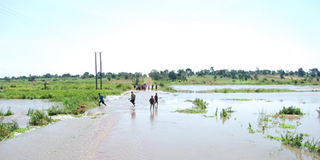Soil erosion is the real land grabber

Human activities which remove vegetation cover and expose soil to erosion contribute to adverse situations like these floods in Kaliro.
My maternal grandfather passed away 10 years before I was born but the “atrocities” he committed during his lifetime continue to haunt me.
One of them was mobilising people to plant paspalum grass to fight soil erosion, which was a big problem in Bulemeezi, where he was a gombolola chief.
More than half a century after he passed on, I keep bumping into bitter old men who have never forgiven my grandfather for forcing them to grow paspalum “as if they were going to eat it”.
Up to now it has not dawned on them that the man who forced them to grow paspalum was helping them save their land from being “grabbed” by soil erosion.
Land abuse
Some things never change. Currently, there is a “land grabbing fever” in the country, which is causing individuals and communities to take extreme measures to defend their land against grabbers.
Cultural leaders are discouraging their subjects from selling off land. At the same time politicians are mobilising their supporters to fight off land grabbers. However, there is no warning that the same people will have no land to defend, if they continue abusing it the way they are doing. The rate and scale of land abuse in this country is scaring. Trees are being felled, swamps are being drained, hill slopes are being cleared of vegetation cover and deadly chemicals are being used in the name of increasing food production.
As a result of these unsustainable farming methods, land is being degraded at a very high rate, posing a big threat to food security.
This is a form of land grabbing that no one is addressing. If land which used to yield 100 bags of maize now yields only 50, it means its size has been reduced by a half. Where has the other half gone? It has been lost through unsustainable farming methods.
Unknown to most farmers, it takes a few years of abuse to turn rich arable land into wasteland where nothing can grow. Degraded land is as good as lost since it is barren.
Causes havoc
Uganda was once home to the most fertile soils, probably on the continent. That is why fertiliser use remains very low among farmers. They had no need for it but the situation is changing.
Soil nutrients are being depleted at a very high rate without being replaced. Every rain season, tonnes of top soil are eroded and deposited into water bodies where it causes havoc ranging from silting to flooding.
In places like Nakasongola, where trees and other vegetation have been cleared to create open grazing land, strong winds carry off tonnes of rich top soils during the dry season.
Primitive view
Strangely, while land owners spend millions to protect their land from encroachers and grabbers, they will hardly make an effort to protect that land from erosion caused by wind and water.
The problem stems from the way we view land. In most cultures, it is treated as a measure of wealth not as a resource to create wealth. The more land, the wealthier you are considered to be. A farmer with 10 acres of overgrown bush is considered wealthier than the one with an acre of intensively farmed land.
Whenever I introduce myself as a farmer, the first question is: How big is your farm? Very few bother to ask how productive it is.
This primitive view is unfortunately affecting our farming sector. Many would-be farmers, especially the youth, are their dreams on hold because they do not have land.
They think that to be taken as a serious farmer, you have to own land, the more the better. Some buy land and then get stuck because there are no resources to develop it.
Bigger threat
Meanwhile “mercenary farmers” come in from as far as Kenya, hire or lease land for a few seasons, and earn a lot of money. They find the price for hiring or leasing land in Uganda laughable. In Nakaseke, the going rate is Shs100, 000 per acre a year (two seasons).
From that one acre, the enterprising mercenary farmer can easily make Shs1m in a year. They do not have to use fertilisers since, in most cases, the land has been idle for a long time, and they will use the most deadly chemicals because they do not own the land. When the land gets “tired” they move to another landlord.
In such a situation, they do not need to waste money buying land, when they can get it almost free. They leave that to local farmers who have sentimental attachment to land.
We need realise that unsustainable farming methods and poor soil management are a bigger threat to land than encroachers and grabbers who we are being warned about.
The author is a farming journalist and consultant.
[email protected]




